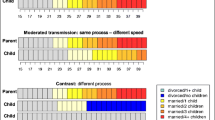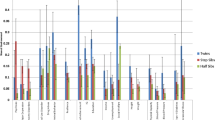Abstract
In analyses of family data, multiple direct association processes can be modeled by the use of delta path methods derived by Van Eerdewegh (1982), especially the transitivity principle. The method is described for the case of an adoption study involving potential selective matching of adopting parents to two sets of biological parents of adopted offspring in the presence of assortative mating for both wed and unwed couples. Second- and third-order delta paths may be derived by application of the transitivity principle, and these higher-order paths are very convenient in formulating expectations that are due to direct and indirect association processes. Expectations are derived for resemblance among all adults in this three-couple adoption system; examples are given also for deriving parent-offspring expectations to illustrate the general use of higher-order delta paths in structural models of familial resemblance. Matrix notation is employed in order to facilitate the application of the methods in developmental and/or multivariate models.
Similar content being viewed by others
References
Carey, G. (1986). A general multivariate approach to linear modeling in human genetics.Am. J. Hum. Genet. 39:775–786.
Fisher, R. A. (1918). The correlation between relatives on the supposition of Mendelian inheritance.Trans. Roy. Soc. Edinburgh 52:399–433.
Fulker, D. W. (1988). Genetic and cultural transmission in human behavior. In Weir, B. S., Eisen, E. J., Goodman, M. M., and Namkoong, G. (eds.),Proceedings of the Second International Conference on Quantitative Genetics, Sinauer, Sunderland, Mass., pp. 318–340.
Pearson, K. (1992). Mathematical contributions to the theory of evolution. XI. On the influence of natural selection on the variability and correlation of organs.Phil. Trans. Roy. Soc. London Ser. A 200:1–66.
Phillips, D. K. (1988).Quantitative Genetic Analysis of Longitudinal Trends in IQ in the Colorado Adoption Project, Unpublished doctoral dissertation, Univversity of Colorado, Boulder.
Phillips, K., Fulker, D. W., and Rose, R. J. (1987). Path analysis of seven fear factors in adult twin and sibling pairs and their parents.Genet. Epidemiol. 4:345–355.
Phillips, K., Fulker, D. W., Carey, G., and Nagoshi, C. T. (1988). Direct martial assortment for cognitive and personality variables.Behav. Genet. 18:347–356.
Rice, J., Cloninger, C. R., and Reich, T. (1978). Multifactorial inheritance with cultural transmission and assortative mating. I. Description and basic properties of unitary models.Am. J. Hum. Genet. 30:618–643.
Van Eerdewegh, P. (1982).Statistical Selection in Multivariate Systems with Applications in Quantitative Genetics, Unpublished doctoral dissertation, Washington University, St. Louis, Mo.
Author information
Authors and Affiliations
Rights and permissions
About this article
Cite this article
Phillips, K. Delta path methods for modeling the effects of multiple selective associations in adoption designs. Behav Genet 19, 609–620 (1989). https://doi.org/10.1007/BF01066027
Received:
Accepted:
Issue Date:
DOI: https://doi.org/10.1007/BF01066027




